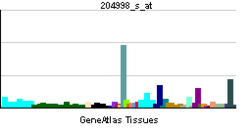ATF5
| View/Edit Human | View/Edit Mouse |
Activating transcription factor 5, also known as ATF5, is a protein that, in humans, is encoded by the ATF5 gene.[3]
Function
First described by Nishizawa and Nagata,[4] ATF5 has been classified as a member of the activating transcription factor (ATF)/cAMP response-element binding protein (CREB) family.[5][6]
ATF5 transcripts and protein are expressed in a wide variety of tissues, in particular, high expression of transcripts in liver. It is also present in a variety of tumor cell types.
ATF5 expression is regulated at both the transcriptional and translational level.
ATF5 is expressed in VZ and SVZ during brain development.
The human ATF5 protein is made up of 282 amino acids.
ATF5 is a transcription factor that contains a bZip domain.
See also
Interactions
ATF5 has been shown to interact with DISC1[7] and TRIB3.[8]
References
- ↑ "Human PubMed Reference:".
- ↑ "Mouse PubMed Reference:".
- ↑ "Entrez Gene: ATF5 activating transcription factor 5".
- ↑ Pati D, Meistrich ML, Plon SE (July 1999). "Human Cdc34 and Rad6B ubiquitin-conjugating enzymes target repressors of cyclic AMP-induced transcription for proteolysis". Mol. Cell. Biol. 19 (7): 5001–13. doi:10.1128/mcb.19.7.5001. PMC 84326
 . PMID 10373550.
. PMID 10373550. - ↑ Hai T, Hartman MG (July 2001). "The molecular biology and nomenclature of the activating transcription factor/cAMP responsive element binding family of transcription factors: activating transcription factor proteins and homeostasis". Gene. 273 (1): 1–11. doi:10.1016/S0378-1119(01)00551-0. PMID 11483355.
- ↑ Vinson C, Myakishev M, Acharya A, Mir AA, Moll JR, Bonovich M (September 2002). "Classification of human B-ZIP proteins based on dimerization properties". Mol. Cell. Biol. 22 (18): 6321–6335. doi:10.1128/MCB.22.18.6321-6335.2002. PMC 135624
 . PMID 12192032.
. PMID 12192032. - ↑ Morris JA, Kandpal G, Ma L, Austin CP (Jul 2003). "DISC1 (Disrupted-In-Schizophrenia 1) is a centrosome-associated protein that interacts with MAP1A, MIPT3, ATF4/5 and NUDEL: regulation and loss of interaction with mutation". Hum. Mol. Genet. 12 (13): 1591–1608. doi:10.1093/hmg/ddg162. PMID 12812986.
- ↑ Zhou Y, Li L, Liu Q, Xing G, Kuai X, Sun J, Yin X, Wang J, Zhang L, He F (May 2008). "E3 ubiquitin ligase SIAH1 mediates ubiquitination and degradation of TRB3". Cell. Signal. 20 (5): 942–948. doi:10.1016/j.cellsig.2008.01.010. PMID 18276110.
Further reading
- Pati D, Meistrich ML, Plon SE (1999). "Human Cdc34 and Rad6B ubiquitin-conjugating enzymes target repressors of cyclic AMP-induced transcription for proteolysis". Mol. Cell. Biol. 19 (7): 5001–13. doi:10.1128/mcb.19.7.5001. PMC 84326
 . PMID 10373550.
. PMID 10373550. - White JH, McIllhinney RA, Wise A, Ciruela F, Chan WY, Emson PC, Billinton A, Marshall FH (2001). "The GABAB receptor interacts directly with the related transcription factors CREB2 and ATFx". Proc. Natl. Acad. Sci. U.S.A. 97 (25): 13967–13972. doi:10.1073/pnas.240452197. PMC 17684
 . PMID 11087824.
. PMID 11087824. - Peters CS, Liang X, Li S, Kannan S, Peng Y, Taub R, Diamond RH (2001). "ATF-7, a novel bZIP protein, interacts with the PRL-1 protein-tyrosine phosphatase". J. Biol. Chem. 276 (17): 13718–26. doi:10.1074/jbc.M011562200. PMID 11278933.
- Morris JA, Kandpal G, Ma L, Austin CP (2004). "DISC1 (Disrupted-In-Schizophrenia 1) is a centrosome-associated protein that interacts with MAP1A, MIPT3, ATF4/5 and NUDEL: regulation and loss of interaction with mutation". Hum. Mol. Genet. 12 (13): 1591–1608. doi:10.1093/hmg/ddg162. PMID 12812986.
- Yamada S, Ohira M, Horie H, Ando K, Takayasu H, Suzuki Y, Sugano S, Hirata T, Goto T, Matsunaga T, Hiyama E, Hayashi Y, Ando H, Suita S, Kaneko M, Sasaki F, Hashizume K, Ohnuma N, Nakagawara A (2004). "Expression profiling and differential screening between hepatoblastomas and the corresponding normal livers: identification of high expression of the PLK1 oncogene as a poor-prognostic indicator of hepatoblastomas". Oncogene. 23 (35): 5901–5911. doi:10.1038/sj.onc.1207782. PMID 15221005.
- Liu W, Sun M, Jiang J, Shen X, Sun Q, Liu W, Shen H, Gu J (2004). "Cyclin D3 interacts with human activating transcription factor 5 and potentiates its transcription activity". Biochem. Biophys. Res. Commun. 321 (4): 954–960. doi:10.1016/j.bbrc.2004.07.053. PMID 15358120.
- Forgacs E, Gupta SK, Kerry JA, Semmes OJ (2005). "The bZIP transcription factor ATFx binds human T-cell leukemia virus type 1 (HTLV-1) Tax and represses HTLV-1 long terminal repeat-mediated transcription". J. Virol. 79 (11): 6932–6939. doi:10.1128/JVI.79.11.6932-6939.2005. PMC 1112100
 . PMID 15890932.
. PMID 15890932. - Al Sarraj J, Vinson C, Thiel G (2005). "Regulation of asparagine synthetase gene transcription by the basic region leucine zipper transcription factors ATF5 and CHOP". Biol. Chem. 386 (9): 873–879. doi:10.1515/BC.2005.102. PMID 16164412.
- Angelastro JM, Canoll PD, Kuo J, Weicker M, Costa A, Bruce JN, Greene LA (2006). "Selective destruction of glioblastoma cells by interference with the activity or expression of ATF5". Oncogene. 25 (6): 907–916. doi:10.1038/sj.onc.1209116. PMID 16170340.
- Wei Y, Jiang J, Sun M, Chen X, Wang H, Gu J (2006). "ATF5 increases cisplatin-induced apoptosis through up-regulation of cyclin D3 transcription in HeLa cells". Biochem. Biophys. Res. Commun. 339 (2): 591–596. doi:10.1016/j.bbrc.2005.11.054. PMID 16300731.
- Kakiuchi C, Ishiwata M, Nanko S, Kunugi H, Minabe Y, Nakamura K, Mori N, Fujii K, Yamada K, Yoshikawa T, Kato T (2007). "Association analysis of ATF4 and ATF5, genes for interacting-proteins of DISC1, in bipolar disorder". Neurosci. Lett. 417 (3): 316–321. doi:10.1016/j.neulet.2007.02.054. PMID 17346882.
- Watatani Y, Ichikawa K, Nakanishi N, Fujimoto M, Takeda H, Kimura N, Hirose H, Takahashi S, Takahashi Y (2008). "Stress-induced translation of ATF5 mRNA is regulated by the 5'-untranslated region". J. Biol. Chem. 283 (5): 2543–2553. doi:10.1074/jbc.M707781200. PMID 18055463.
External links
- ATF5 protein, human at the US National Library of Medicine Medical Subject Headings (MeSH)
This article incorporates text from the United States National Library of Medicine, which is in the public domain.

